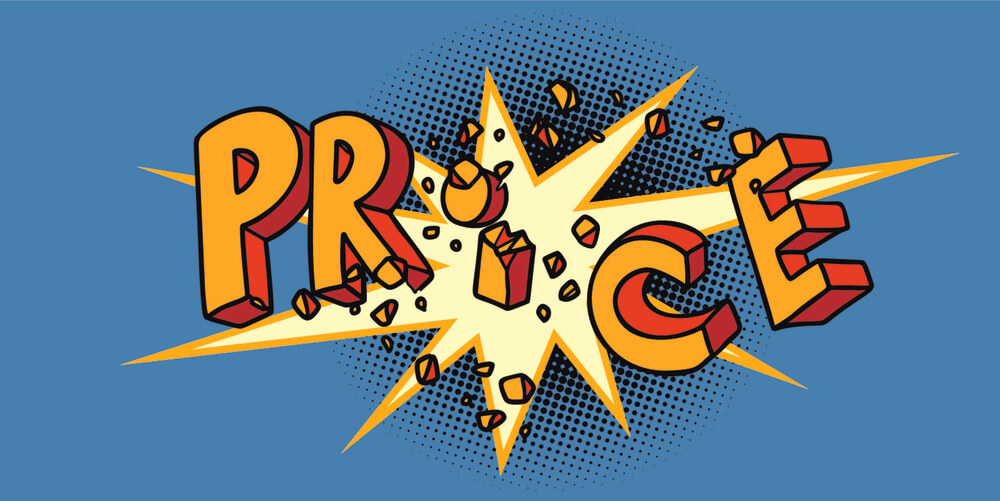Last Updated on August 30, 2025 by Dave Schoenbeck
Developing and implementing a competitive pricing strategy for your business is crucial to staying competitive in the long term.
Your pricing strategy will affect the goals you can set and achieve, your profit margins, and how you market your products to your consumers.
However, determining effective pricing strategies isn’t as easy as it seems. You should consider your target audience, competitors, the demand for your products, and overall market trends that could impact your sales, among other factors. In addition, before choosing your business’s best pricing strategy, you must know what options are available.
Different Types of Pricing Strategies
There are many different business pricing strategies on the market. You encounter some of them whenever you go to the grocery store or purchase a new cable or Internet package. However, not all of them will work for every type of business. Here is a list of the most common and effective pricing strategies that you’ll encounter in the wild:
- Discount pricing strategy: Setting a price and temporarily lowering it for a special sale or promotion creates a sense of urgency that encourages customers to make a purchase.
- High-low pricing : This involves charging a higher price for an item when demand is high but lowering the price as demand decreases.
- Market penetration pricing: Initially offering a product for a low price to penetrate the market and set yourself apart from competitors, potentially raising the price later.
- Psychological pricing: You see this all the time in retail stores—marking an item as an insignificantly lower price, such as $4.97 instead of $5, to trick the mind into thinking it’s more affordable. Many sellers use varying last price digits to signify different meanings to the staff.
- Premium pricing : Artificially inflating a price to make a product seem exclusive and aspirational.
- Variable pricing: Involves adjusting prices up or down as the market changes. It’s wise to make these adjustments occasionally, even if this isn’t your primary strategy. Many companies adjust their pricing in response to demand. For example, consider a seasonal beach or hotel business that flexes pricing based on the week of the year.
- Leader pricing: Setting a low price, even taking a loss, introducing customers to your brand or product for the first time.
- Cost-based (cost plus) pricing: Pricing your product so that you’ll turn a profit once you account for materials and labor costs. This is a very standard pricing model.
- Value pricing: involves setting prices based on what your target audience thinks your product is worth. This requires some market research to pinpoint.
- Competition-based pricing: Pricing your products based on how much your competition charges for theirs (ideally offering a better value than theirs).
- Price skimming pricing: This competitive pricing strategy involves setting your prices at the maximum that your target audience is willing to pay and slowly lowering them over time as those customers drop off to target new audiences.
- Everyday low pricing: Walmart is renowned for this pricing strategy, which involves offering a low price daily without requiring customers to wait for a sale or special occasion.
- Demand-based pricing is self-explanatory—setting prices based on your perceptions and studying customer demand observations.
- Differential pricing : Setting customer prices based on various factors, such as age, veteran status, loyalty programs, etc.
- Product bundle pricing: Involves offering a discount when a customer buys multiple products. Have you taken advantage of the buy one, get one free offer?
- Geographical pricing: Setting different prices for different geographic locations.
- Promotional pricing: Temporarily reducing the price of a product due to a sale, special event, or another kind of promotion.
- Captive pricing: Charging what you want for a product or service because people will have no choice but to buy it. This only works if you have no real competitors.
- Freemium pricing: Offering a basic or limited version of your product for free, with customers later paying for more or better features. This can include offering a free trial.
- Decoy pricing: Adding a less appealing option when comparing several items. The idea is to add a less valuable decoy than the higher-priced item.
- Unlimited pricing: This could be an all-you-can-eat option or a ski pass for the entire season for one price.
- A la carte/drip pricing: The value airlines use this with a cheap entry ticket and add additional services for a fee. Customers often underestimate the impact of fees, which can lower your pricing impression.
- Pricing by unconventional time increments: A lower price is offered for nontraditional use periods. Early bird movie tickets or travel during off-hours
- Payment over time pricing: Examples include car loans, party tents, and other similar products.
- Prepaid plans pricing: An example is a prepaid hotel or car rental that can’t be changed or canceled.
- Capped or flat-rate pricing: Moving companies use this as a single price to move your home.
- Future options pricing: Travel companies use this to lock in prices before purchasing.
- Volume pricing: Furniture retailers often use a “buy more and save” offer.
- Progressive pricing: The price increases over time, for example, for same-day tickets or discounts for advance conference registration.
- Auction pricing: Priceline and eBay are famous for this approach.
- Subscription pricing: Streaming services and home meal kits are great examples.
- Initiation fee pricing: Perfect examples are a country club and gym memberships
- Pay-what-you-want pricing: This allows customers to choose their own payment amount. This works well with donations and special promotions.
- Seasonal pricing: Prices adjust according to seasonal or holiday periods. This is common in the retail and tourism industries.
- Tiered pricing: Offer different price levels based on the number of users or features provided.
- Captive product pricing: Develop a core product that requires accessories or add-ons to function, pricing the main product lower but making profits on the necessary extras.
- Free trial pricing: Offer customers limited-time, complimentary access to your product or service, enabling them to experience its value before committing.
- Loss leader pricing: Retailers commonly use this strategy to drive foot traffic. They price well-known products below cost to attract customers and allow full profit on accessory items.
- Anchor pricing: A psychological tactic that involves displaying a higher reference price alongside the actual selling price to create a perception of value.
- Dynamic pricing: Adjust prices in real-time based on market demand, customer behavior, and other factors. Airlines and ride-hauling companies use this tactic.
- Kit or bundle pricing: Bundle complementary products together at a combined price lower than the sum of individual prices. A good way to introduce new products while maintaining high prices
- Geographical pricing: Set different prices based on location. Fuel stations and agricultural products use this strategy.
- Freemium pricing: Offer a basic product version for free while charging for advanced features.
- Net price strategy: Develop a clear structure for net prices that can be quickly applied across several scenarios and segments.
Some of these strategies are less savory than others, but I’ve included them because many businesses choose to use them. You should be aware of your competitors’ effective pricing strategies and adjust yours accordingly.
What is the Best Pricing Strategy for a New Business?
Your competitive pricing strategy will depend on your product, the market, your customer base, and various other factors unique to your company. However, for a new business, there are several key considerations to keep in mind.
First, you’ll have less leeway because you haven’t established a reputation for your brand or product. Because of this, you’ll be limited in terms of the most common pricing strategies you can realistically choose from. Freemium pricing is a great option, allowing customers to experience your product without committing to a high price point.
First, consider strategies that involve setting your prices lower than those of your competitors to encourage their customers to try your product. Market penetration pricing was designed to help with this tactic.
Once you’ve established your place in the market, you can branch out to other effective pricing strategies. Additionally, it will be easier to keep up with your competitors once you’re widely recognized as an alternative.
Remember that customer loyalty is the ultimate goal of whichever competitive pricing strategy you use in the long run. As a result, the pricing strategy that nets you the most income might not be the one that encourages your target audience to return repeatedly.
Don’t become so hungry for profit that you isolate the customers who support you or resort to shady sales tactics. Ultimately, the most effective pricing strategies allow you to operate your business with integrity and brand consistency.
Success Factors for Your Pricing Strategies
I have looked far and wide for pricing experts, and I finally found a book that you should strongly consider reading. The book is titled “Confessions of the Pricing Man,” written by Hermann Simon. He is one of the world’s premier experts on pricing strategy, and reading his book is critical for establishing a new business pricing strategy. I wish I had found this book years ago.
His book is chock-full of great ideas, but here is a short version and interesting analysis of his success factors for four major pricing strategies:
Success Factors for an Ultra-low Pricing Strategy
- Think “simple yet robust”.
- Develop locally.
- Lock in the lowest cost production and expenses.
- Apply new low-cost marketing and sales approaches.
- You must be “easy to use, easy to fix”
- Provide consistent quality.
Success Factors for a Low-Price Strategy
- Begin with a low price strategy from day one.
- Must be highly cost-efficient.
- Must guarantee adequate and consistent quality.
- A strong focus on core products, without implying expanded services.
- Focus on high growth and high-revenue execution.
- Must be a procurement champion/expert.
- Maintain low debt.
- Control as much as you possibly can.
- Focus advertising on price.
- Don’t mix your messaging. Stay in your lane.
- Understand your role and don’t drift.
Success Factors for a Premium Pricing Strategy
- Superior value is a must.
- The price-value relationship is the decisive competitive advantage.
- Innovation is the foundation.
- Consistent, high quality is a must.
- Premium pricers have strong, dominant brands.
- Premium pricers invest heavily in communication.
- Premium pricers shy away from special offers.
Success Factors for a Luxury Goods Pricing Strategy
- Luxury goods must consistently deliver the highest level of performance.
- The prestige effect is a significant driver.
- Price contributes to the prestige effect and serves as a quality indicator
- Volume and market share must remain within strict limits.
- Strictly avoid discounts, special offers, and similar actions.
- Top talent throughout your company is essential.
- Having control of the value chain is advantageous
- The primary factor in price setting is the customer’s willingness to pay.
Determining a pricing strategy for your business can be a trial-and-error process. An outside perspective can be a valuable resource. Please fill out my contact form for a complimentary coaching call with a professional business coach who can help you develop and refine your competitive pricing strategy. I am not a fan of arbitrarily pricing at the low end of the market. Pricing is about imagery, and I like helping companies interested in positioning their business differently, rather than just being the cheapest. Let’s work together to crystallize a robust pricing strategy for your business.
Coach Dave
- The Cheat Code for How to Build an Effective Winning Team - December 11, 2025
- A Practical Guide on How to Create a Business Strategy That Works - December 4, 2025
- Entrepreneur Anxiety is a Disturbed Relationship with Certainty - November 28, 2025


